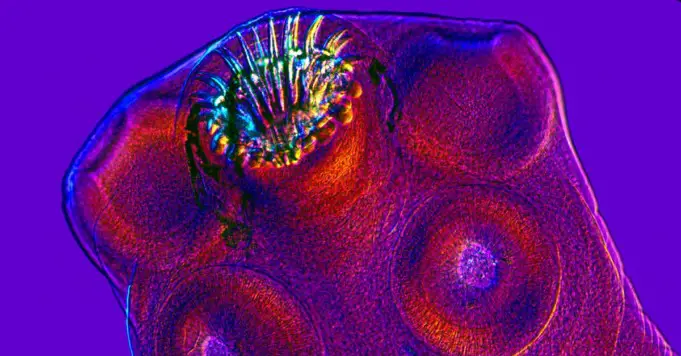Taeniasis is an infection of the intestines caused by adult tapeworms, a type of parasite that belongs to the genus Taenia. Parasites are small orgasms that attach themselves to other living things called hosts for sustenance and survival.
The disease typically has no or only mild symptoms, which may include abdominal pain or weight loss. The species of tapeworms responsible for causing taeniasis in humans are:
- Taenia solium (pork tapeworm)
- Taenia saginata (beef tapeworm)
- Taenia asiatica (Asian tapeworm)
Taenia solium and Taenia asiatica occur by eating contaminated undercooked pork, while Taenia saginata is due to eating undercooked beef that has been infected.
The diagnosis of the infection is by examining stool samples where parts of the tapeworm can be observed. Infection by the Taenia solium tapeworm can lead to cysticercosis, which causes seizures.
These tapeworms can be found all over the world. Eating raw and undercooked pork or beef can increase the chances of getting infected.
Eastern Europe, Eastern Africa, Russia, and Latin America are some regions where contaminated raw beef is consumed. Taenia saginata related taeniasis is rare in the United States except in areas with a high concentration of people and cattle and with poor sanitation.
Low-income and under-developed communities have a high incidence of tapeworm infections due to Taenia solium. This has been observed in communities in sub-Saharan Africa, Eastern Europe, Asia, and India.
This specie of tapeworm can be found in the United States, especially amongst Latin American Immigrants. Taenia asiatica is restricted to Asia, especially China, Taiwan, Thailand, and Indonesia.
Cysticercosis occurs when the eggs of the Taenia solium species are ingested. For instance, people with taeniasis living in areas with poor hygiene will shed tapeworm eggs in their feces, which may be passed into the environment, consequently leading to the transmission of cysticercosis to themselves or others.
Causes and Risk Factors of Taeniasis
The causal agents of taeniasis are tapeworms. The eggs of these organisms are passed along with fecal matter and can survive for days to months.
The animal hosts – cows for T. saginata and pigs for T. solium – become infected when they consume vegetation contaminated with the eggs.
These eggs hatch in the animal’s intestine, invade the intestinal walls, and move to the muscles where they develop into cysticerci. These cysticerci can survive up to several years in the animal host.
Humans become hosts when they ingest raw or undercooked meat that has been contaminated with the eggs.
The cysticercus takes over two months to grow into an adult tapeworm, which can also survive for several years. These adult tapeworms attach themselves to the small intestine with sucking features known as scolex.
The length of adult worms may be up to 30 m. These adult tapeworms produce proglottids that mature, become gravid, and then detached from the parent tapeworm.
The proglottids move to the anus and are passed along with feces.
Signs and Symptoms of Taeniasis
Nausea, abdominal pain, constipation and diarrhea, unexpected weight loss, and blockage of the intestine are symptoms that can be caused by fully developed tapeworms.
People may also experience irritation in the area around the anus. This happens when the tapeworm is passed out with the stool and can occur approximately two months after consuming meat infected with the cysticerci.
Although sometimes mild, these symptoms can continue until the tapeworm dies after treatment. It can, however, live for several years if there is no treatment.
Many people may be asymptomatic for years in the case of taeniasis due to T. solium. In some parts of the world where the disease is endemic, people who have been infected may develop a visible by beneath the skin.
Neurocysticercosis, a complication of taeniasis, has been associated with a variety of symptoms, which include blindness, meningitis, chronic headaches, seizures, epilepsy dementia, and lesions in the central nervous system.
Diagnosis
Taeniasis can be diagnosed by examining stool samples of the infected individual. The infected person may also be asked if they have passed out parts of the tapeworm in their stool recently.
These specimens may be collected over a number of days and examined under a microscope. The tapeworm eggs can be observed in fecal matter in about eight to twelve weeks after the tapeworm infection has been confirmed.
Treatment of Taeniasis
The World Health Organization (WHO) recommends using praziquantel or niclosamide for the treatment of taeniasis. A single dose of 5-10 mg/kg of praziquantel may be administered, while for adults and children over the age of 6 require 2 g of a single dose of niclosamide after a light meal.
Children between the ages of 2-6 may take 1 g while children under the age of 2 may take 500 g.
Prolonged courses of praziquantel along with albendazole may be required in cases of cysticercosis, where destruction of the cysts may lead to inflammation. Corticosteroids, anti-epileptic cases, and possibly surgery may be needed in extreme cases.
Prevention and Control of Taeniasis
Taeniasis may be prevented in the following ways:
- Wash hands with soap and water for about 20 seconds after using the toilet and before handling food.
- Community education and awareness of the importance of washing hands to prevent infection.
- Wash and peel raw fruits and vegetables properly before eating.
- Imbibe good food and water safety when traveling to areas endemic with taeniasis.
- Proper storage and preparation of meat using methods like salting and refrigerating.
- Vaccination and proper treatment of cows and pigs against the disease
- Improved environmental sanitary practices.
- Improved livestock husbandry practices.
- Regular health inspection of meat to reduce the spread of the disease.












